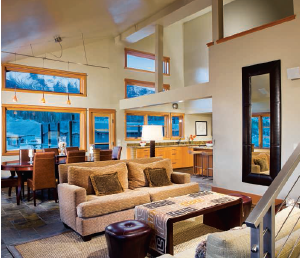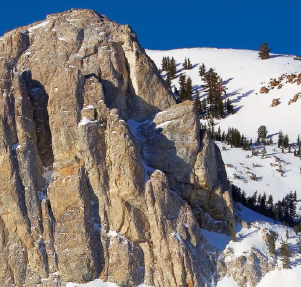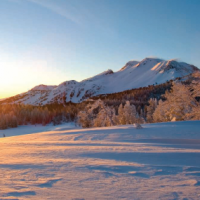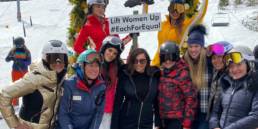Best Ski Resorts Mammoth Undertaking
The Legendarily Laid Back California Sky Area Faces The Future And The Change It Brings Story By Roger Toll Photos by Christian Pondella. Photos courtesy of Mammoth Mountain Ski Area
In the 70’s, Mammoth felt like locals’ hill. Simple, Friendly, and a little warn at the hills, it was a humble, get-it-yourself kind of place, where boot bags were pushed carelessly under wooden benches, and sneakers and socks mingled helter-skelter with brown bag lunches and wadded-up clothing brought on long overnight drives from Los Angeles. On weekends, more than 20,000 people would make the six-hour trek for some of the best ski terrain and deepest snowpack in America. Long lift queues wandered off like conga lines, and the rock concert atmosphere was a little crazy. But during the week, you had all that acre age to yourself. Those were the halcyon days of Dave McCoy, Mammoth’s legendary founder, who was always around, like the cool uncle you wanted to work for during the summer. When the recession of the late 1980s hit, Mammoth found itself beholden to its banks. McCoy looked at the Colorado ski areas that had begun catering to a high-end audience with luxury frills and amenities, and saw a future he didn’t like. So in the mid-’90s he sold a minority share to Intrawest, the Canadian developer behind Whistler’s enormous success, thinking it had the magic formula. Intrawest built a handsome, lift-accessed, Euro-style ski village in the middle of Mammoth Lakes, importing a little flair to the ramshackle town and linking it to the mountain for the first time. To locals, it felt like a French tart from Pigalle had just moved to Peoria . It turned out to be a difficult partnership, but Intrawest’s investment in real estate fomented an economic resurgence in Mammoth Lakes and a boom that put the ski area on the road to recovery. By 2005, Mammoth was debt-free and worth $365 million — a 16 fold increase in value in eight years. It was the right time for the 90-year-old McCoy to sell the ski area he had birthed 65 years earlier. Among 18 bidders, Barry Sternlicht’s Starwood Capital Group won out. Like it or not, the ski area has evolved from a seat-of-the-pants, passion-driven family business to a corporate entity with deep pockets and an eye on the bottom line. It’s the story of the industry’s last 20 years. While the old-time ski hills charm with simplicity and personality, it’s the modern ski resort’s buffed amenities, sharp-edged efficiency, and five-star customer service that today’s patrons seem to love. With high-speed lifts, computerized snowmaking, manicured slopes, deluxe day lodges, and gourmet food courts, modern skiers are spoiled. But satisfying customer expectations has become an expensive business, and the price of skiing has skyrocketed.
 Mammoth has had a hard time adjusting to the new-school model, thanks to the town’s populist spirit, as well as generations of loyalists who don’t want to see change and a founder who liked it just fine the old-fashioned way. “Mammoth was built with fun,” McCoy says, looking back. “It was my sandbox, the tools and lifts were my toys, and all my friends would come and play beside me. Everyone participated because of their love for the place, customers and employees side by side, hand in hand. Heart. Love. Respect. Friendship. We had fun! That’s what made Mammoth great.” The Los Angeles boy first visited the eastern Sierra Nevada in 1928, when he was just 13 years old. At 20, he took a job as hydrographer for Los Angeles’ Department of Water and Power, tracking snow depths in the mountains that provide the city’s water. Finding that the snow was deepest in and around Mammoth Mountain, he put up a movable rope tow on weekends in 1937, powering it by wrapping the rope around the wheel of an old Model A. He built the first ski lodge in 1953, and incorporated the ski area two years later. Soon this ragged-edged, idiosyncratic ski area, devoid of pretensions— laid-back like Los Angeles, like a surfing beach in the mountains — had more visitors than any other ski area in all of North America.
Mammoth has had a hard time adjusting to the new-school model, thanks to the town’s populist spirit, as well as generations of loyalists who don’t want to see change and a founder who liked it just fine the old-fashioned way. “Mammoth was built with fun,” McCoy says, looking back. “It was my sandbox, the tools and lifts were my toys, and all my friends would come and play beside me. Everyone participated because of their love for the place, customers and employees side by side, hand in hand. Heart. Love. Respect. Friendship. We had fun! That’s what made Mammoth great.” The Los Angeles boy first visited the eastern Sierra Nevada in 1928, when he was just 13 years old. At 20, he took a job as hydrographer for Los Angeles’ Department of Water and Power, tracking snow depths in the mountains that provide the city’s water. Finding that the snow was deepest in and around Mammoth Mountain, he put up a movable rope tow on weekends in 1937, powering it by wrapping the rope around the wheel of an old Model A. He built the first ski lodge in 1953, and incorporated the ski area two years later. Soon this ragged-edged, idiosyncratic ski area, devoid of pretensions— laid-back like Los Angeles, like a surfing beach in the mountains — had more visitors than any other ski area in all of North America.
Tucked up a side valley just north of Bishop, Mammoth sits on the remote eastern slope of the Sierra Nevada. It attracts upward of a million skiers and snowboarders a year, putting it among the five most-visited ski resorts in North America. Almost all of those visitors still trek up from sprawling southern California like pilgrims each weekend. A dated highway connects Mammoth to Los Angeles, 300 miles to the south, and Reno, 170 miles north, the closest major airports. While Mammoth is near the top 10 in overall ski resort ratings, it is among the worst in accessibility. “The best way for us to grow beyond our traditional base is to get more flights into the Mammoth airport,” says Mammoth CEO Rusty Gregory, McCoy’s longtime lieutenant. Regular service into Mammoth Lakes’ airport, the ski area’s long-sought holy grail, was finally inaugurated last season with a daily Horizon Air round-trip flight from Los Angeles. Its success has allowed Gregory to negotiate an additional flight from Los Angeles and daily round-trip flights from Seattle and Portland through Reno and San Jose, respectively. Gregory arrived at Mammoth in 1978, a 25-year-old from southern California with a pedigree in surfing and a B.A. in accounting, signing on as a lift operator. In 1983 he became head of human resources; four years later McCoy promoted him to chief administrative officer, thanks to his way with numbers and people. With finance as one of his many responsibilities, he piloted the company through California’s deep recession of 1989- 90, building value during several treacherous years. His work was validated when McCoy named him CEO in 1995, then added chairman to his title four years later. With an easygoing, unpretentious style and a commitment to transparency, Gregory is successfully leading the mountain into its new corporate era. Unlike many ski resort managers, he engages residents and leaders, offering town hall talks to the locals, engaging critics with straight talk, and sharing company information. In a recent dialogue on a Mammoth internet forum, he signed his name with the title “Lift Operator & CEO.” And when executives considered changing the company’s handle from the unaffected “ski area” to the loftier “mountain resort,” Gregory nixed it; the official name remains Mammoth Mountain Ski Area. “There really isn’t any other mountain resort like us culturally,” says Gregory. “The informal, nonjudgmental, egalitarian vibe we have here is uniquely southern Californian. People say, ‘Oh, Mammoth now wants to become Vail or Aspen.’ But that’s not true. We want to continue being what we are, but with more services to attract destination skiers. I don’t think we’re going to lose what we’re all about.” “Rusty is a good man, and hugely intelligent,” Andrea Mead Lawrence said last January, shortly before succumbing to cancer. A U.S. skiing icon and two-time gold medal Olympian, Lawrence was the town’s longtime moral voice and leading anti-development activist. “I think Rusty has got important things to do in giving us direction. He wants to work for the best interests of the town.” Even so, she feared the new ownership would bring changes for the worse. As the daughter of the founders of Vermont’s Pico Peak, she believed that you run a ski area because of love for the sport and lifestyle, a charming but unrealistic fantasy nowadays. “The cost of skiing has become so exorbitant,” she said. “That stops families we used to have from coming up here. And the higher-income people who can afford the prices don’t fit in here easily. Sternlicht is cracking the whip now. It’s the whole corporate thing. The ski area has to develop double-digit profits. I cringe at that.” It’s not about profits but cash flow, Gregory is quick to say. Sternlicht’s purchase created a large debt that must be serviced. Things have been good despite the economic downturn, but Gregory is working to diversify the customer base to attract skiers from beyond SoCal. “We’ve been successful as a regional resort,” he notes, “but our capacity for business in town — the infrastructure of hotels and restaurants and other services — is underutilized during the week and over utilized on weekends. We want to diversify our market risk and have a more even flow of business during both midweek and weekends. With that added revenue, we may even be able to offer greater discounts as incentives. It also allows us to do what Andrea always advised: ‘Just make sure that you use everything you’ve already built before you build anything else.’ “We don’t want to overwhelm our personality with too much development,” he adds. “The two have to stay in tandem. The more we can define the resort by the people who live here, the better off we are. The physical plant is so dominant at some resorts that they lose their unique culture.” Mammoth’s strategy for growth consists of cautious steps forward, restrained development, environmental sensitivity, a focus on the mountain, and a lot of communication. Growth will come from making gradual improvements in mountain services, customer care, restaurants and lodgings, and things to do after skiing. The first step was Intrawest’s village, followed by improvements in lift capacity, speed, and positioning. Last year Gregory focused on upgrading the food and beverage services. And this season will bring expanded flight service into the local airport. “We need to keep hyper-focused on what people want today,” Gregory says. “Mammoth is changing only so far as what people want is changing. It’s no different than Dave McCoy and his friends hiking up the mountain on their wood skis in the early days and saying, ‘Hey, this would be a lot easier with a rope tow!’ So you build a rope tow. Today people are telling us, ‘We want to keep coming, but you have to make sure it’s not too expensive.’ I think if skiers get what they want, they’ll reward you. It’s a matter of creating the right things for them, at all price levels.”

In the afternoon, the towering wall of the high sierra throws a long shadow over Dave McCoy’s ranch-style home on the outskirts of Bishop, 30 minutes from Mammoth. Now 94, he hopes to get back on skis again this season after two knee replacements had him hobbling through last winter’s snowfalls. In the meantime he is pursuing his second passion, photographing high-desert landscapes, and talking with old friends and colleagues. “Those big corporations running ski areas today don’t have any heart,” he says. “They can take your last penny from your pocket, then walk away and say, ‘Hey, sorry, buddy. You may not have another meal, but I’m going to go party.’ They can ruin so many people’s lives. “Howcanfolkspay$100 foraliftticket andfoodfor the day?” His eyes are moist with emotion. “We had dormitories, we had college kids, we had families. It was inexpensive. Some people would carry gas up the mountain for a lift ticket or shovel off a deck for lunch.” Yes, skiing today is better, more accessible, with perfect grooming and creative terrain parks, but the number of skiers and boarders has been static for years. As the economy of ski towns forces many to leave, resorts cater more and more to the prosperous. But thanks to the influence of its founder and its egalitarian ethos, Mammoth seems to be seeking a third way to grow and develop, one that looks first to its own population’s sustainability. It would be a fitting tribute to McCoy’s legacy. “Today, everything is better, but they’ve pushed out all the people who can’t afford the prices. It’s a crying shame. If they gave me Mammoth today, I couldn’t run it. I’m too simple,” he says, his gaze riveted in the distance. “But I’ll tell you one thing. That mountain should belong to everybody.”





